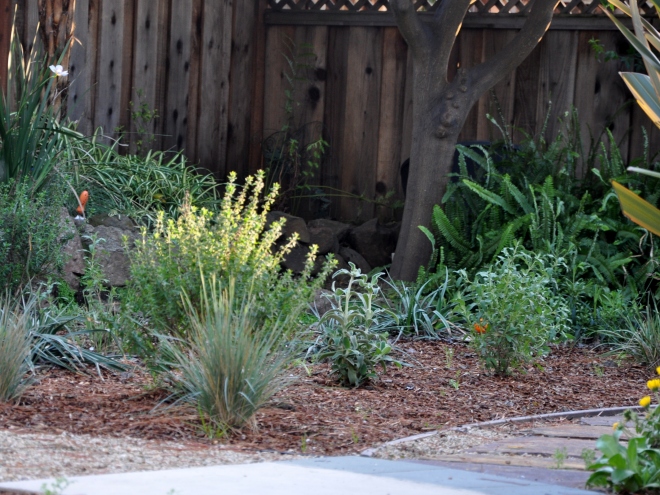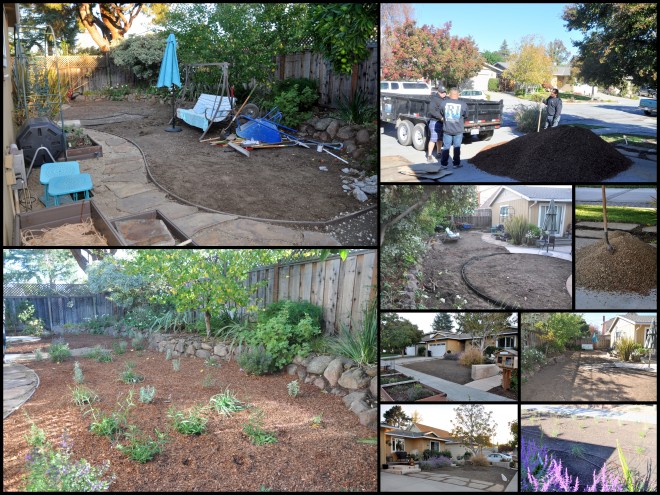There are a number of things to consider when converting lawn to native plants. Economics is one of them. Up front costs are costly if you are unable to do the work yourself. If you live in the Bay Area/Silicon Valley as we do, labor is expensive.
When we bought this house in our thirties, my husband and I did most of the work ourselves. We spent hours removing ivy, digging a faux creek, planting and hauling stones from a quarry in the back of my hatchback. I mowed the lawn with a push-mower, and reluctantly got down on my hands and knees every few weeks to trim the blades of grass away from the curb.
Then life became more complex. I had two boys, three years apart, one requiring a number of early interventions. My husband traveled for one or two weeks each month and often worked long hours beyond a typical day. It made more sense to pay for big jobs then to attempt to do them ourselves. We’re both pretty handy, but we knew our limits.
Now that life is simpler again, I turned my back for five minutes and I’m now in my fifties.
What?
So while we now have more time, we lack the strength and the energy. Between the two of us we have problems with our backs, feet and knees. We used some of our savings instead.
Here’s the math:
Professional landscape design and installation: $7,658
This included labor for hauling of old sod and other debris, site prep, laying of irrigation, planting and mulch. A crew of three worked for five days to complete the project.
Material costs included irrigation pipe and emitters, edging, pea gravel, paving stones for the swing area and plants.
The Santa Clara Water District offered a handsome rebate incentive for converting your lawn. After submitting all the paper work, I received a $2,530 rebate.
This reduced the overall cost by a third, bringing the price down to $5,128.
I am no longer paying a lawn service, saving $1,800 a year in maintenance alone this year or $3,600 over the next 24 months. There will be additional savings in our water bill as well.
Between the rebate and the savings on lawn maintenance, the overall out-of-pocket cost of the conversion is about $1,528. In three years, the project will have paid for itself.
Why replace your lawn? Here’s a handy list published by Green Town Los Altos:
1. Healthier Creeks. Fertilizers, herbicides and pesticides are top polluters in our creeks, killing aquatic life and spreading disease.
2. Less Storm Water Runoff. Deep roots of native plants and trees surrounded by mulch retain more water on site.
3. More Free Time. Native plants don’t require fertilizer, herbicides, pesticides and benefit only from annual or semiannual pruning.
4. Save Water. Lawns require more water than our climate can provide. Reducing our draw of water from the Delta and the Sierras helps maintain their ecosystems.
5. Save Money. All the mowing, fertilizer, herbicides and irrigation of lawns cost a lot of money. Native plants need substantially less effort and money to maintain.
6. Cash for Grass. Santa Clara Valley Water District will pay you up to $2000 to replace your lawn. Note: Sadly, this program is currently out of money, but local citizens can put their name on the waiting list.
7. Good Bugs, Not Bad Bugs. Mosquitoes in our dry summer? There must be a lawn nearby. Frequent watering creates tiny pools just right for mosquitoes to breed. Native plants attract good bugs and birds, ones that eat mosquitoes and other pests.
8. Biodiversity. Other than hardscape, there isn’t a more inhospitable surface to biodiversity than the mono-culture of lawns.
9. Less Greenhouse Gases. Manufacture and transportation of fertilizers, herbicides, pesticides, and mowers has a substantial carbon footprint. Transportation, pumping and treatment of water requires energy. When you save water, you also save energy!
10. Smart Choice. Landscaping with plants that are native to our climate is a smart choice. If you want soft areas for kiddies to roll in, native grasses come in all three flavors: seeds, plugs and sod.
You can read the full article at Green Town Los Altos.
One last thing: An amazing thing has happened since removing the lawn. Now that I’m taking care of the entire garden once again, I feel more connected to my little patch of earth. It’s been a welcome and unexpected gift.



